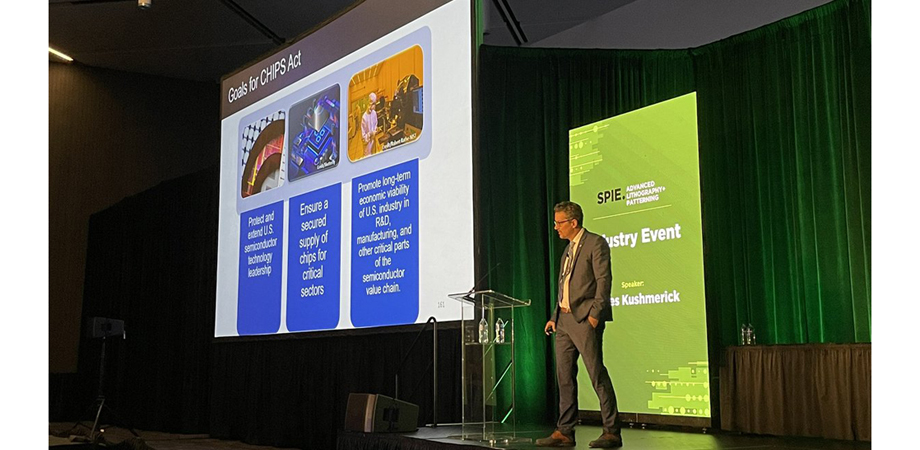Causes and cures for the chip shortage

On Tuesday night during the 2022 SPIE Advanced Lithography and Patterning conference, panelists representing all aspects of semiconductor manufacturing discussed the chip shortage and what to do about it. Just prior to the panel, an event covered the CHIPS for America Act, which touches on a solution to future semiconductor shortages.
“The driver behind our chip shortage is primarily customers,” said Bruce Tuft, vice president and director of fab materials operations at chip maker Intel, in opening the panel discussion.
In a Q&A after the panel, he added that this is part of a big megatrend. The power of Moore’s Law has driven the costs of computing, communication, and sensing so low that semiconductors are everywhere. So, demand for them is high.
Within that overarching trend, there have been some recent surprises. For example, Tuft and other panelists pointed to demand for older technology, semiconductors that have feature sizes measured in the tens of nanometers and not the single digit feature sizes of the most advanced chips.
Chris Progler, chief technical officer at mask maker Photronics, noted that demand for older technology mask sets tends to decline year after year. In the past two years though, demand for such masks actually went up substantially.
That surge in mask orders presents problems for the relatively small photomask industry, Progler said. “It’s really hard to meet that demand in the commercial mask industry today.”
Since masks weren’t available, fabs couldn’t make those products. That, in turn, contributed to the semiconductor shortage.
In addition to high demand, there were also supply chain problems impacting chip manufacturing. For instance, regarding the chemical’s used to make chips, Mark Slezak, president of lithography and process materials supplier JSR, said that the lead time has moved from two to six months out to 10 to 14 months. Much of that increase is due to high demand coming from outside the semiconductor industry, which uses a small volume of very tightly specified and high performing materials. Being small and demanding means getting sub-suppliers to respond takes some effort and skill.
“The strength of our relationship with our sub-suppliers is so critical,” Slezak said.
He noted that those sub-suppliers want is better demand visibility. So along with other solutions, he advocated the semiconductor industry do a better job identifying volume needs to remove materials as a cause for future chip shortage.
Better visibility as a solution to chip shortages also came up from Dan Hutcheson, CEO of the analyst firm VLSI Research. He looked at auto industry demand, noting that it dropped from 10 to four percent of overall semiconductors as car makers slammed on the brakes during the pandemic. That abrupt drop then moved through the four supply chain tiers between auto makers and semiconductor producers.
The application of just-in-time delivery methods took inefficiencies out of supply chains, lowering costs. But just-in-time can make the supply chain act like a heavily traveled highway where minor accidents cause massive traffic jams.
“Just-in-time made the system extremely coherent and very fragile,” Hutcheson said.
He noted that such disruptions don’t last forever. Chip demand from the auto industry, for instance, started to drop at the end of 2021 after peaking earlier.
“The lack of visibility has been a problem for the whole industry,” agreed Raman Achutharaman, group vice president for technology, strategy, and marketing at the Semiconductor Products Group with equipment supplier Applied Materials.
He said that chip shortages affect Applied Materials’ ability to make products that, in turn, are used to make chips. Achutharaman thinks that visibility into chip demand and supply chains will get better. Such information will help lessen the current and future chip shortages.
Christine Dunbar, vice president of product management in the CWI Business Unit at GlobalFoundries, also cited visibility and just-in-time as issues that needed addressing along with the need for better relationships all along the supply chain. Taking these steps will help alleviate chip shortages. What’s more, since chip factories are so expensive, no company can afford to build one and hope customers will come. So, commitments regarding chip purchases and other long-term solutions will help.
There is one other risk factor, though. That came up during a Q&A where Dunbar noted a mismatch between the size of the technical workforce and the surging appetite for semiconductors.
“We just don’t have the folks to meet this demand,” she said.
Part of the solution to that came up in the earlier CHIPS for America information event. In it, James Kushmerick, director of the Physical Measurement Laboratory at the National Institute of Standards and Technology (NIST), talked about the legislation. Kushmerick said hopes are that CHIPS will become law by end of May.
In its current form, CHIPS appropriates $52 billion over five years to revitalize the US semiconductor industry. That money goes to a variety of programs, including research, a manufacturing center, and more. There is a thread that runs throughout these efforts, one that might play a role in preventing future chip shortages by beefing up the labor pool.
“There’s workforce development across the board,” Kushmerick said of the legislation.
Hank Hogan is a science writer based in Reno, Nevada.
| Enjoy this article? Get similar news in your inbox |
|



